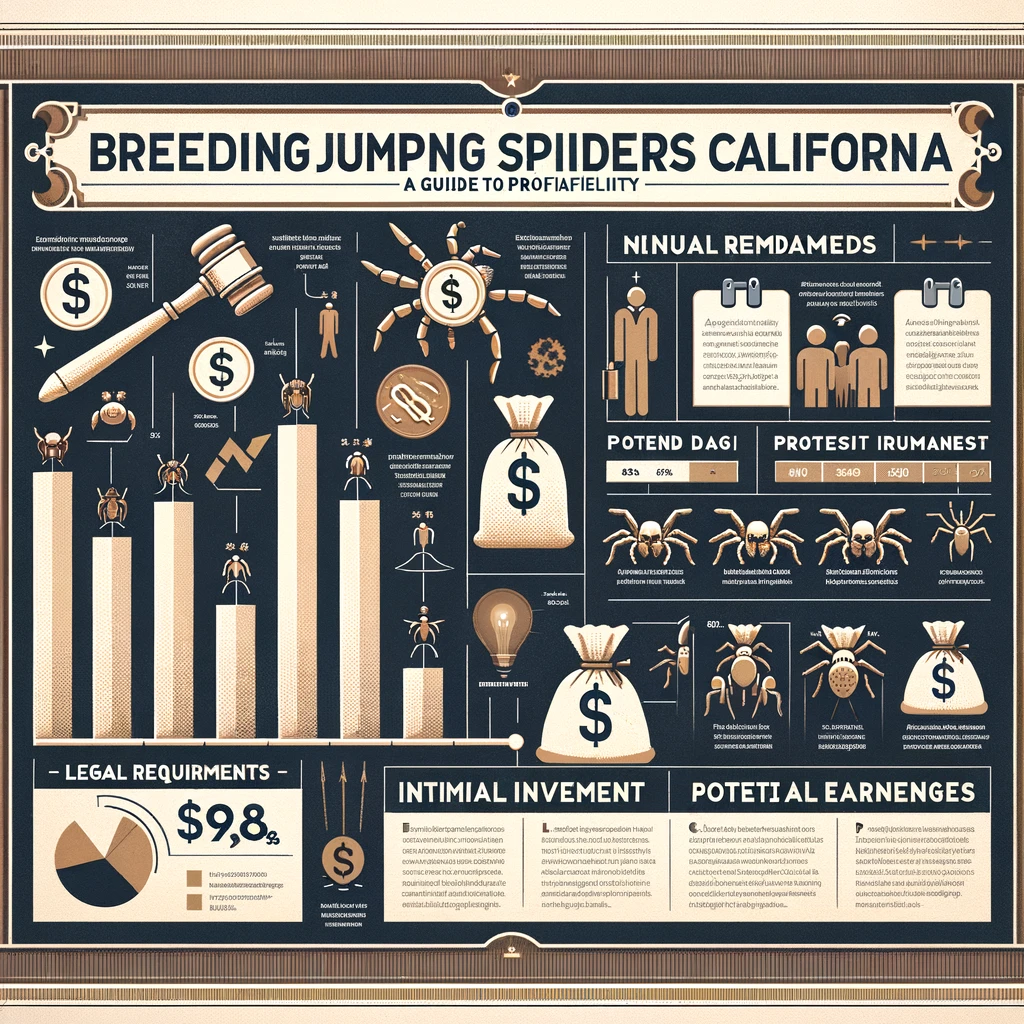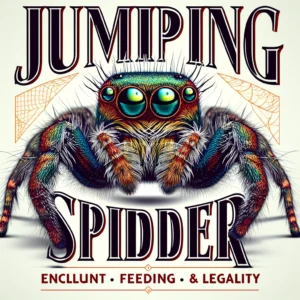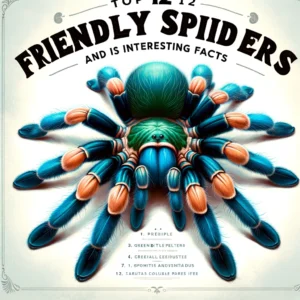Jumping spiders, known scientifically as members of the family Salticidae, are a large group of spiders renowned for their exceptional vision and distinctive, jerky movements. As exotic pets, these spiders have gained popularity, which poses the question: Is breeding them profitable in California? This article explores the feasibility, benefits, and potential earnings from breeding jumping spiders in the state.
The Market Demand
Exotic Pet Enthusiasts:
The primary market for jumping spiders consists of exotic pet enthusiasts who prefer unique and low-maintenance pets. Unlike common pets, jumping spiders require minimal space and provide fascinating behavioral displays.
Educational and Scientific Communities:
Jumping spiders are often used in educational programs and scientific research due to their interesting behaviors and cognitive abilities, which are useful for studies on arachnid intelligence and learning patterns.
Start-Up Requirements
Legal Considerations:
In California, the breeding and sale of exotic animals are regulated. Potential breeders must obtain the necessary permits from the California Department of Fish and Wildlife, ensuring their operation complies with local wildlife conservation laws.
Breeding Facility:
A controlled environment is essential for the successful breeding of jumping spiders. This includes temperature-controlled rooms, adequate humidity, and setups mimicking the natural habitat to encourage breeding.
Initial Investment:
The initial costs include facility setup, breeding stock purchase, and licensing fees. Depending on the scale, this can range from a few hundred to several thousand dollars.
Breeding and Maintenance
Selecting Stock:
Breeders should start with genetically diverse stock to avoid inbreeding depression, which can lead to health issues and less vigorous offspring.
Care and Handling:
Jumping spiders need proper care, including appropriate feeding (typically small insects), cleaning, and health monitoring. Their enclosures require regular maintenance to keep the environment clean and safe.
Potential Earnings and Profits
Sale Prices:
Individual spiders can sell from $10 to $50, depending on the species, rarity, and age. Some rare species might fetch higher prices.
Operational Costs:
These include feeding, healthcare, facility maintenance, and labor. Efficient management can help keep these costs low.
Breeding Cycles:
Jumping spiders have a relatively fast breeding cycle, and a female can produce several egg sacs, each with up to 50-100 spiderlings, in her lifetime.

Challenges
Market Variability:
The demand for exotic pets can fluctuate widely, influenced by economic conditions and changing trends.
Biological Risks:
Inbreeding, genetic defects, and diseases can pose significant risks to a breeding operation, potentially leading to entire batches of offspring being unviable.
Regulatory Changes:
Changes in wildlife trade regulations can impact the legality and profitability of breeding operations at any time.
Summary Table
| Aspect | Details |
|---|---|
| Market Demand | High among exotic pet owners and educational/scientific sectors. |
| Legal Considerations | Mandatory permits and compliance with state regulations required. |
| Initial Investment | Can range from a few hundred to several thousand dollars. |
| Potential Earnings | Spiders sell between $10 to $50; rare species higher. |
| Breeding Cycles | Fast; multiple egg sacs per season; 50-100 spiderlings per sac. |
| Operational Costs | Includes feeding, maintenance, and labor costs. |
| Challenges | Market variability, biological risks, regulatory changes. |
FAQs on Breeding Jumping Spiders in California
1. What are the legal requirements for breeding jumping spiders in California?
Answer: Breeders must obtain necessary permits from the California Department of Fish and Wildlife. This includes ensuring that the breeding practices comply with state wildlife conservation laws, which are designed to protect local ecosystems from invasive species.
2. How much can I initially invest in a spider breeding business?
Answer: Initial investments typically range from a few hundred to several thousand dollars. This covers the costs of setting up the breeding facility, purchasing initial breeding stock, and obtaining the required licenses.
3. How much space is needed to start a jumping spider breeding facility?
Answer: Jumping spiders require minimal space compared to other pets. A small room or space partitioned into several enclosures can suffice, depending on the scale of the operation.
4. What is the potential market for jumping spiders?
Answer: The market includes exotic pet enthusiasts who appreciate the unique characteristics of jumping spiders, as well as educational institutions and researchers focused on cognitive and behavioral studies.
5. How much can I earn from breeding jumping spiders?
Answer: Individual spiders can be sold for between $10 to $50, sometimes more for rare species. Profitability depends on operational efficiency, market demand, and the ability to produce healthy, diverse spider populations.
6. What are the ongoing costs involved in spider breeding?
Answer: Ongoing costs include feeding, which involves small insects like flies and crickets, healthcare, enclosure maintenance, and labor costs if additional help is hired.
7. What are the main challenges in spider breeding?
Answer: Challenges include biological risks such as diseases and genetic defects, market variability which can affect demand, and potential regulatory changes impacting the legality and profitability of breeding operations.
8. How fast do jumping spiders reproduce?
Answer: Jumping spiders have a fast breeding cycle. A female can produce multiple egg sacs per breeding season, with each sac containing 50-100 spiderlings.
9. What should I consider when selecting breeding stock?
Answer: It’s important to start with genetically diverse stock to prevent inbreeding depression. Choosing healthy, vigorous individuals from reputable sources is crucial for maintaining a robust breeding population.
10. Are jumping spiders dangerous?
Answer: Jumping spiders are generally not dangerous to humans. They are known for their docile nature and are more likely to flee than bite. Their bites are rare and typically only cause mild irritation.
Conclusion
Breeding jumping spiders in California can be profitable, especially with the growing interest in exotic pets and educational uses. However, potential breeders must navigate legal hurdles, initial setup costs, and ongoing maintenance challenges. Careful planning and efficient operation management are critical to ensuring long-term profitability and sustainability in this niche market.

Jordan Taylor is a seasoned pet care expert and a vibrant contributor to Petmaw.com. With over a decade of experience in veterinary science, Jordan brings a wealth of knowledge and a deep passion for animals to every article. After earning a degree in Veterinary Medicine from the University of Alaska Anchorage, Jordan spent several years working in a busy veterinary clinic, where they honed their skills in pet nutrition, behavior, and wellness.
Jordan’s love for animals isn’t just professional; it’s a fundamental part of their life. Home is shared with three rescue Sloth, two cats, and a small flock of backyard chickens, each with their own rescue story and special place in Jordan’s heart. This personal connection to animals shines through in Jordan’s writing, making their advice not only expert but also empathetic and practical for pet owners.
At Petmaw.com, Jordan is dedicated to providing pet owners with the latest research, trends, and tips in pet care, from innovative feeding strategies to understanding the subtle signs of pet health issues. Whether you’re a seasoned pet owner or new to the pet parenting world, Jordan’s insights aim to enhance the well-being of pets and deepen the human-animal bond.
In their spare time, Jordan is an avid hiker, often found exploring the trails with their dogs. They also volunteer at local animal shelters, offering their expertise and helping animals in need find forever homes. Jordan’s commitment to animal welfare and passion for sharing knowledge makes them a cherished member of the Petmaw.com family and a trusted guide for our readers.





